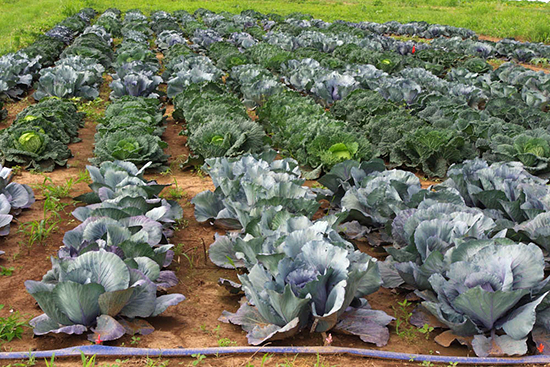Cabbage
Cabbage (Brassica oleracea) is a cool-season crop with a high cold tolerance; however, heads may bolt (flower prematurely) in warm temperatures. Cabbage is mainly grown for fresh market sales in Kentucky, where growers have in the past planted significant contracted acreage for the processing market.
Marketing

Fresh market options for Kentucky cabbage producers include wholesale marketing through produce auctions and cooperatives, as well as restaurants and local retailers. Direct markets for fresh cabbage include farmers markets, roadside stands and Community Supported Agriculture (CSA) shares. Fresh cabbage sales are heavily influenced by fresh-cut coleslaw consumption and the use of red cabbage in salad mixes. Fresh cabbage use per capita has declined substantially in recent years, from 8.9 pounds per capita in 2000 to 6.3 pounds in 2016. Access to fresh-cut processing will be critical for Kentucky producers seeking profitability from large-scale cabbage production.
Production
 Growers should consider head size (small to large), shape (round, flat-round, conical and variations), density, and color (green, blue-green or red), as well as leaf texture (smooth or savoy). Wrapper leaves (number, thickness and tightness) and core length can also vary among cultivars. Typically, cabbage heads grown for processing are much larger than those grown for the fresh market. Growers should consider growing varieties with the largest head size when producing for the processing market. Resistance and/or tolerance is available for Fusarium yellows, black rot, tip burn and bolting. Some varieties are better suited for fall production than spring production. Select locally adapted varieties that have the qualities in demand for the intended market.
Growers should consider head size (small to large), shape (round, flat-round, conical and variations), density, and color (green, blue-green or red), as well as leaf texture (smooth or savoy). Wrapper leaves (number, thickness and tightness) and core length can also vary among cultivars. Typically, cabbage heads grown for processing are much larger than those grown for the fresh market. Growers should consider growing varieties with the largest head size when producing for the processing market. Resistance and/or tolerance is available for Fusarium yellows, black rot, tip burn and bolting. Some varieties are better suited for fall production than spring production. Select locally adapted varieties that have the qualities in demand for the intended market.

